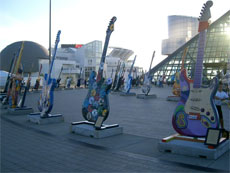
There is nothing more closely associated with Rock and Roll than the electric guitar. It grew up with Rock, and has been onstage throughout The Golden Age of Rock.
Like Rock music, the history of the electric guitar starts early. In the 1930s, jazz musician Charlie Christian was using an amplified guitar for solos, and in the early 1940s, Aaron Thibeaux “T-Bone” Walker recorded with one, but it wasn’t until Leo Fender introduced the first mass produced model in 1950 with the introduction of the Broadcaster (soon renamed the Telecaster), that the electric guitar became popular.
The Telecaster is still in production today, and is favored by many artist for it’s bright, cutting tone. Fender followed it up in 1954 with the Stratocaster, a 3 pickup model (the Telecaster had 2) that included a cutaway for easier reach to the upper registers, and a revolutionary vibrato or “tremolo” unit that would allow players to bend strings as they played by wiggling the tremolo arm, or “whammy bar”. Along with the Telecaster and Stratocaster, Fender introduced the Precion Bass, or P-Bass, remains one of the most popular basses in music today.
Fender wasn’t the only electric guitar innovator. The Gibson Mandolin-Guitar Company had been making electric instruments for many years, and their their “Electric Spanish” model, the ES-150, was generally recognized as the first commercially successful electric guitar as early as 1936. It wasn’t until 1952 though, when Gibson launched a solid-bodied guitar designed in collaboration with Les Paul that they gained fame.
Les Paul popularized the electric guitar in the early 1950s with a series of recordings with his wife Mary Ford using several new types of technologic innovations. His invention of multitrack recording, mixing seperate recordings together was made possible by the of introduction of reel-to-reel audio tape recording. Paul would record a track, then record himself playing another part with the first. This multitrack method has become the standard for how modern recordings are made.
Another hero in the history of the electric guitar is Chuck Berry, who established a style of playing in the late 1950s that remains a great influence on rock music. His style today is the basis for stage performances of many groups, and was featured in a famous segment by Michael J Fox in the movie “Back To The Future”.

The importance of the electric guitar to Rock music is demonstrated by the sculptures outside of the Rock and Roll Hall of Fame.
The late 1960s a new generation of rock guitarists arose, including Jimi Hendrix, Eric Clapton, and Carlos Santana. Perhaps influenced by the psychedelic style of the time, they experimented with twisting the sound through amplification, feedback (electronic sound distortion), and add-on electronic devices, extending the musical potential of the instrument.
All of this led to a major change in the composition of a band. Where before the introduction of the electric guitar, a pop band was almost a “mini-big-band”, with horns (usually a sax), double standup bass, and a piano or organ, with the strong sounds of the electric guitar, the 4 man band became popular, with an electric bass, rhythm guitar, drums and a lead. Each of the instruments were strong enough to carry their own part, and versatile enough for each band to create their own style.